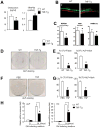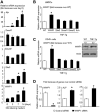Tumor necrosis factor inhibits mesenchymal stem cell differentiation into osteoblasts via the ubiquitin E3 ligase Wwp1
- PMID: 21809421
- PMCID: PMC3708970
- DOI: 10.1002/stem.703
Tumor necrosis factor inhibits mesenchymal stem cell differentiation into osteoblasts via the ubiquitin E3 ligase Wwp1
Abstract
Patients with chronic inflammatory disorders, such as rheumatoid arthritis, often have osteoporosis due to a combination of Tumor necrosis factor-induced increased bone resorption and reduced bone formation. To test if TNF inhibits bone formation by affecting the commitment and differentiation of mesenchymal stem cells (MSCs) into osteoblasts, we examined the osteogenic potential of MSCs from TNF transgenic (TNF-Tg) mice, a model of chronic inflammatory arthritis. MSC-enriched cells were isolated from bone marrow stromal cells using negative selection with anti-CD45 antibody coated magnetic beads. The expression profile of MSC surface markers the osteogenic, chondrogenic, and adipogenic properties of CD45(-) cells were confirmed by FACS and cell differentiation assays. MSC-enriched CD45(-) cells from TNF-Tg mice formed significantly decreased numbers of fibroblast and ALP(+) colonies and had a decreased expression of osteoblast marker genes. As TNF may upregulate ubiquitin ligases, which negatively regulate osteoblast differentiation, we examined the expression levels of several ubiquitin ligases and found that Wwp1 expression was significantly increased in MSC-enriched CD45(-) cells of TNF-Tg mice. Wwp1 knockdown rescued impaired osteoblast differentiation of TNF-Tg CD45(-) cells. Wwp1 promotes ubiquitination and degradation of JunB, an AP-1 transcription factor that positively regulates osteoblast differentiation. Injection of TNF into wild-type mice resulted in decreased osteoblast differentiation of MSCs and increased JunB ubiquitination, which was completely blocked in Wwp1(-/-) mice. Thus, Wwp1 targets JunB for ubiquitination and degradation in MSCs after chronic exposure to TNF, and inhibition of Wwp1 in MSCs could be a new mechanism to limit inflammation-mediated osteoporosis by promoting their differentiation into osteoblasts.
Copyright © 2011 AlphaMed Press.
Figures






Similar articles
-
Ubiquitin E3 ligase Wwp1 negatively regulates osteoblast function by inhibiting osteoblast differentiation and migration.J Bone Miner Res. 2013 Sep;28(9):1925-35. doi: 10.1002/jbmr.1938. J Bone Miner Res. 2013. PMID: 23553732 Free PMC article.
-
Smurf1 inhibits mesenchymal stem cell proliferation and differentiation into osteoblasts through JunB degradation.J Bone Miner Res. 2010 Jun;25(6):1246-56. doi: 10.1002/jbmr.28. J Bone Miner Res. 2010. PMID: 20200942 Free PMC article.
-
Ubiquitin e3 ligase itch negatively regulates osteoblast differentiation from mesenchymal progenitor cells.Stem Cells. 2013 Aug;31(8):1574-83. doi: 10.1002/stem.1395. Stem Cells. 2013. PMID: 23606569 Free PMC article.
-
Regulatory Roles of E3 Ubiquitin Ligases and Deubiquitinases in Bone.Biomolecules. 2025 May 7;15(5):679. doi: 10.3390/biom15050679. Biomolecules. 2025. PMID: 40427572 Free PMC article. Review.
-
E3 ubiquitin ligase-mediated regulation of bone formation and tumorigenesis.Cell Death Dis. 2013 Jan 17;4(1):e463. doi: 10.1038/cddis.2012.217. Cell Death Dis. 2013. PMID: 23328670 Free PMC article. Review.
Cited by
-
The role of E3 ubiquitin ligases in bone homeostasis and related diseases.Acta Pharm Sin B. 2023 Oct;13(10):3963-3987. doi: 10.1016/j.apsb.2023.06.016. Epub 2023 Jul 6. Acta Pharm Sin B. 2023. PMID: 37799379 Free PMC article. Review.
-
WWP1: a versatile ubiquitin E3 ligase in signaling and diseases.Cell Mol Life Sci. 2012 May;69(9):1425-34. doi: 10.1007/s00018-011-0871-7. Epub 2011 Nov 4. Cell Mol Life Sci. 2012. PMID: 22051607 Free PMC article. Review.
-
TNF-α inhibits SATB2 expression and osteoblast differentiation through NF-κB and MAPK pathways.Oncotarget. 2017 Dec 18;9(4):4833-4850. doi: 10.18632/oncotarget.23373. eCollection 2018 Jan 12. Oncotarget. 2017. PMID: 29435145 Free PMC article.
-
Effects of Interleukin-17A on Osteogenic Differentiation of Isolated Human Mesenchymal Stem Cells.Front Immunol. 2014 Sep 2;5:425. doi: 10.3389/fimmu.2014.00425. eCollection 2014. Front Immunol. 2014. PMID: 25228904 Free PMC article.
-
Ubiquitin E3 ligase Itch negatively regulates osteoblast function by promoting proteasome degradation of osteogenic proteins.Bone Joint Res. 2017 Mar;6(3):154-161. doi: 10.1302/2046-3758.63.BJR-2016-0237.R1. Bone Joint Res. 2017. PMID: 28298321 Free PMC article.
References
-
- Canalis E. Effects of tumor necrosis factor on bone formation in vitro. Endocrinology. 1987;121:1596–1604. - PubMed
-
- Li YP, Stashenko P. Proinflammatory cytokines tumor necrosis factor-alpha and IL-6, but not IL-1, down-regulate the osteocalcin gene promoter. J Immunol. 1992;148:788–794. - PubMed
-
- Nanes MS. Tumor necrosis factor-alpha: Molecular and cellular mechanisms in skeletal pathology. Gene. 2003;321:1–15. - PubMed
-
- Gilbert L, He X, Farmer P, et al. Expression of the osteoblast differentiation factor RUNX2 (Cbfa1/AML3/Pebp2alpha A) is inhibited by tumor necrosis factor-alpha. J Biol Chem. 2002;277:2695–2701. - PubMed
-
- Diarra D, Stolina M, Polzer K, et al. Dickkopf-1 is a master regulator of joint remodeling. Nat Med. 2007;13:156–163. - PubMed
Publication types
MeSH terms
Substances
Grants and funding
LinkOut - more resources
Full Text Sources
Other Literature Sources
Molecular Biology Databases
Research Materials
Miscellaneous

